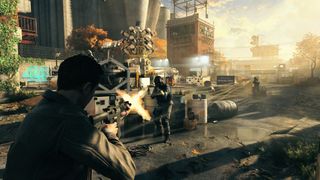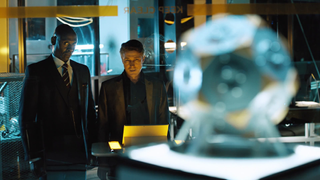Remedy took us into the time-bending realm of Quantum Break, where TV and video game worlds collide
At Gamescom 2015, I joined Xbox marketing head Aaron Greenberg for an extended look at Quantum Break.


Quantum Break is a third-person shooter developed by Remedy, the brains behind Alan Wake and Max Payne. Both games used other forms of media to tell their stories. Max Payne 1 and 2 had stylish graphic novel segments between missions, and Alan Wake used live-action in-game and in some prequel shorts.
Both titles blended these non-video game elements well, and I'd say such mixtures are almost Remedy's calling card at this point. However, after seeing the live-action elements in Quantum Break, I'm pleased to report that the game represents a gigantic leap forward for the studio.
Quantum Break is still gorgeous, exciting, and mysterious
In our session, we got an extended look at the above stage demo complete with developer commentary from Remedy Games.
Quantum Break looks every bit as crisp and gorgeous as last year's reveal. Remedy's tendency for meticulous detail remains present, only in Quantum Break it's accentuated as a gameplay necessity. Minor objects that could get away with low-polygon counts in other games take center stage in Quantum Break. This is because you're often thrown into the center of destructive scenes suspended in time.
We got to see the scene that followed the above stage demo. Jack Joyce finds himself faced with the game's antagonist, Paul Serene, who berates him from a chopper above. Serene is portrayed by the excellent Aiden Gillen, who's perhaps known best for playing Petyr Baelish from Game of Thrones. In the trailer, he laments that no matter what he does, he cannot fix time, describing it as a "closed loop". Presumably Paul Serene was driven to insanity by this knowledge, founding the nefarious Monarch Solutions corporation, whose soldiers serve as the game's cannon fodder.
Serene prevents the chopper's gunner from firing on Jack Joyce (Shawn Ashmore), electing instead to use his powers of time manipulation to create a "stutter". Time stutters are destructive environments within the game world, which serve to test a player's reflexes in gorgeously destructive set-pieces. In stutters, reality is breaking down, and the objects and structures within them compress and uncompress as they move back and forth through time. The scenes are equal parts intense and beautiful. The time suspension really showcases the detail Remedy have put into every inch of debris ruined by the chaos.
After Jack survives the environmental onslaught, he's besieged by a Monarch Solutions security force. Paul Serene's technology helps his private army traverse stutters, but Jack can still take advantage of his own time powers to defeat his foes. One of my concerns from previous demos is how frequent Jack can use his abilities. Remedy showed us how each power works, complete with their usage cooldown timers. Each power displays on the right side of the screen with a minimalist icon, a circular bar grows around them to show when they're ready for use again.
Get the Windows Central Newsletter
All the latest news, reviews, and guides for Windows and Xbox diehards.

Some abilities, like Jack's time-bending dash, can be used multiple times until depleted, taking chunks of the cooldown bar with it. Other powers, like his time stoppage field, generate longer periods of downtime. You'll need to use them wisely as you advance through the game's shooting scenarios, and I was told that the powers are still being tuned to make sure they're not overpowered.
Merging live-action TV with a third-person shooter (with minor spoilers)
After the extended gameplay demo, Remedy gave us an expanded glimpse of the live-action TV segments. We now know that Quantum Break features a star-studded cast of Hollywood actors. This includes the aforementioned Shawn Ashmore (X-men) and Aiden Gillen (Games of Thrones). They're joined by Dominic Monaghan (Lord of the Rings), Lance Reddick (The Wire) and various others.
Fans familiar with Remedy's Alan Wake will find that Quantum Break plays out in a similar episodic structure, with important differences. At the end of each act, you'll be presented with a choice. Your decisions not only directly affect the game, but also the 20-minute live-action segments that play between levels as well. Quantum Break's TV segments tell the game's story from the perspective of antagonist Paul Serene and his shadowy corporation Monarch Solutions.

Remedy showed a scene in which Martin Hatch (portrayed by Lance Reddick) is interrogating a young activist. Martin is Paul Serene's right-hand, and as you'd expect, he seems a nasty piece of work. Live-action tends to have a bad name in video games, thanks to awful FMV titles in the 90's and the infamous B-movie opening to the original Resident Evil. However, I vouch heavily for Quantum Break. Its production values are right up there with what you might expect of a Netflix Original or HBO show.
In the scene, Martin Hatch threatens to kill the activist if she doesn't give him the information he wants. She refuses, and Hatch has her shot in the head. Remedy explained that the segment played out as a result of the player's decisions. The rep then showed us an alternative version of events.
If you opt to threaten the activist's family instead, she becomes compliant, and Hatch decides against shooting her. These decisions have consequences in-game as well. Remedy cited the activists on the bridge from the original gameplay trailer. They're rioting against the authorities because the activist from the TV segment got killed. Presumably, if she survived, they wouldn't be present on the bridge later on. The interactivity should give Quantum Break a decent amount of replayability, due to the multiple timelines on disk.

I recalled criticisms of 2008's Metal Gear Solid 4 for having lengthy cut-scenes (often 30+ minutes) in between short gameplay stints. If you skipped Metal Gear Solid 4's cut-scenes, you wouldn't have a clue what was going on (frankly, even if you did watch them it's not the easiest game to follow). I asked Remedy if they'd considered that some gamers might want to skip the live-action segments. The rep told me that the live-action scenes add depth to the story, but exist from another perspective - so if someone did opt to skip the live TV portions, the game itself still provides a coherently contained narrative.
As mentioned earlier, the TV segments follow Monarch Solutions and the antagonists while the game itself follows Jack Joyce and the hero characters. Beyond the decisions players make, sometimes you'll happen upon scenes that have already taken place in-game, but told from another perspective.

One scene showed a policewoman and a Monarch Solutions agent threatening each other at gunpoint, while Jack Joyce remained locked in the back of a police van. The agent wanted to take Jack for Monarch, but in a mere instant, his gun disappeared, as did the policewoman's. Jack had also escaped from the van. The two were left bewildered as the screen went dark. The same scene also plays out in-game, from the perspective of Jack. He uses his powers to escape from the van, freezing the two outside in a field of halted time. He then removes their weapons and leaves as the pair remain helplessly suspended in time.
Live-action future?
When I mentioned Metal Gear Solid 4's exposition-obsessed cut-scenes, Xbox marketing head Aaron Greenberg noted that the almost all Quantum Break's internal testers embraced the live-action scenes. This is despite knowing they could be skipped, and weren't completely integral.
I feel as though this is the game Sam Lake has been gunning for across Remedy's 20-year history. Quantum Break's in-game fidelity, combined with its intersecting live-action show sends my memories of those awful 90s FMV games into a quantum singularity.
Quantum Break arrives at a time when video game movie tie-ins are releasing left, right and center. Assassin's Creed, Warcraft and Minecraft are all hitting the big-screen, all tied to major deals with huge studios.
In an interview with the BBC, Xbox boss Phil Spencer implied that there could be further forays into live-action for Microsoft. "There are certain franchises that we have that lend themselves to video, TV and even potentially movies… so I do think you'll see more."
Quantum Break could be offering us a glimpse at the future, in more ways than one.
Quantum Break launches on April 5th, 2016, exclusively for Xbox One.
Will you be picking up Quantum Break? What Xbox properties would you like to see on the big screen? Hit the comments!

Jez Corden is a Managing Editor at Windows Central, focusing primarily on all things Xbox and gaming. Jez is known for breaking exclusive news and analysis as relates to the Microsoft ecosystem while being powered by tea. Follow on Twitter @JezCorden and listen to his XB2 Podcast, all about, you guessed it, Xbox!
